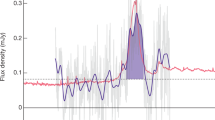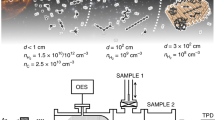Abstract
INTERSTELLAR dust is responsible, through surface reactions, for the creation of molecular hydrogen, the main component of the interstellar clouds in which new stars form. Intermediate between small, gas-phase molecules and dust are the polycyclic aromatic hydrocarbons (PAHs). Such molecules could account for 2–30% of the carbon in the Galaxy1, and may provide nucleation sites for the formation of carbonaceous dust2,3. Although PAHs have been proposed4,5 as the sources of the unidentified infrared emission bands that are observed in the spectra of a variety of interstellar sources6–11, the emission characteristics of such molecules are still poorly understood. Here we report laboratory emission spectra of several representative PAHs, obtained in conditions approximating those of the interstellar medium, and measured over the entire spectral region spanned by the unidentified infrared bands. We find that neutral PAHs of small and moderate size can at best make only a minor contribution to these emission bands. Cations of these molecules, as well as much larger PAHs and their cations, remain viable candidates for the sources of these bands.
This is a preview of subscription content, access via your institution
Access options
Subscribe to this journal
Receive 51 print issues and online access
$199.00 per year
only $3.90 per issue
Buy this article
- Purchase on Springer Link
- Instant access to full article PDF
Prices may be subject to local taxes which are calculated during checkout
Similar content being viewed by others
References
Snow, T. P. & Witt, A. N. Science 270, 1455–1460 (1995).
Tielens, A. G. G. M. in Carbon in the Galaxy: Studies From Earth and Space (eds Tarter, J. C., Chan, S. & DeFrees, D. J.) 59–111 (NASA Conf. Publ. 3061, Moffett Field, 1987).
Cadwell, B. J., Wang, H., Feigelson, E. D. & Frenklach, M. Astrophys. J. 429, 285–299 (1994).
Allamandola, L. J., Tielens, A. G. G. M. & Barker, J. R. Astrophys. J. Suppl. Ser. 71, 733–775 (1989).
Léger, A. & d'Hendecourt, L. Ann. Phys. Fr. 14, 181–206 (1989).
Cohen, M. et al. Astrophys. J. 341, 246–269 (1989).
Geballe, T. R., Lacy, J. H., Persson, S. E., McGregor, P. J. & Soifer, B. T. Astrophys. J. 292, 500–505 (1985).
Witteborn, F. C. et al. Astrophys. J. 341, 270–277 (1989).
de Muizon, M. J., d'Hendecourt, L. B. & Geballe, T. R. Astr. Astrophys. 235, 367–378 (1990).
Schutte, W. A., Tielens, A. G. G. M., Allamandola, L. J., Cohen, M. & Wooden, D. H. Astrophys. J. 360, 577–589 (1990).
Allamandola, L. J. et al. Astrophys. J. 345, L59–L62 (1989).
Petroff, M. D., Stapelbroek, M. G. & Kleinhans, W. A. Appl. Phys. Lett. 51, 406–408 (1987).
Schlemmer, S. et al. Science 265, 1686–1689 (1994).
Allamandola, L. J., Tielens, A. G. G. M. & Barker, J. R. Astrophys. J. 290, L25–L28 (1985).
Léger, A. & Puget, J. L. Astr. Astrophys. 137, L5–L8 (1984).
Shan, J., Suto, M. & Lee, L. C. Astrophys. J. 383, 459–465 (1991).
Williams, R. M. & Leone, S. R. Astrophys. J. 443, 675–681 (1995).
Flickinger, G. C., Wdowiak, T. J. & Gómez, P. L. Astrophys. J. 380, L43–L46 (1991).
Joblin, C., d'Hendecourt, L., Léger, A. & Défourneau, D. Astr. Astrophys. 281, 923–936 (1994).
Joblin, C., Boissel, P., Léger, A., d'Hendecourt, L. & Défourneau, D. Astr. Astrophys. 299, 835–846 (1995).
Allamandola, L. J., Sandford, S. A., Hudgins, D. M. & Witteborn, F. C. in Airborne Astronomy Symposium on the Galactic Ecosystem (eds Haas, M. R., Davidson, J. A. & Erickson, E. F.) 23–32 (Astronomical Soc. of the Pacific, San Francisco, 1995).
Hudgins, D. M. & Allamandola, L. J. J. phys. Chem. 99, 3033–3046 (1995).
Szczepanski, J. & Vala, M. Astrophys. J. 414, 646–655 (1993).
Szczepanski, J., Chapo, C. & Vala, M. Chem. Phys. Lett. 205, 434–439 (1993).
Vala, M. et al. J. phys. Chem. 98, 9187–9196 (1994).
Omont, A. Astr. Astrophys. 164, 159–178 (1986).
Langhoff, S. R. J. phys. Chem. (in the press).
Brenner, J. & Barker, J. R. Astrophys. J. 388, L39–L43 (1992).
Cherchneff, I. & Barker, J. R. Astrophys. J. 341, L21–L24 (1989).
Author information
Authors and Affiliations
Rights and permissions
About this article
Cite this article
Cook, D., Schlemmer, S., Balucani, N. et al. Infrared emission spectra of candidate interstellar aromatic molecules. Nature 380, 227–229 (1996). https://doi.org/10.1038/380227a0
Received:
Accepted:
Issue Date:
DOI: https://doi.org/10.1038/380227a0
This article is cited by
-
Open questions on carbon-based molecules in space
Communications Chemistry (2022)
-
The mystery of unidentified infrared emission bands
Astrophysics and Space Science (2022)
-
Water versus Asphaltenes; Liquid–Liquid and Solid–Liquid Molecular Interactions Unravel the Mechanisms behind an Improved Oil Recovery Methodology
Scientific Reports (2019)
-
Catalytic Performance of Biomass Carbon-Based Solid Acid Catalyst for Esterification of Free Fatty Acids in Waste Cooking Oil
Catalysis Surveys from Asia (2015)
Comments
By submitting a comment you agree to abide by our Terms and Community Guidelines. If you find something abusive or that does not comply with our terms or guidelines please flag it as inappropriate.



